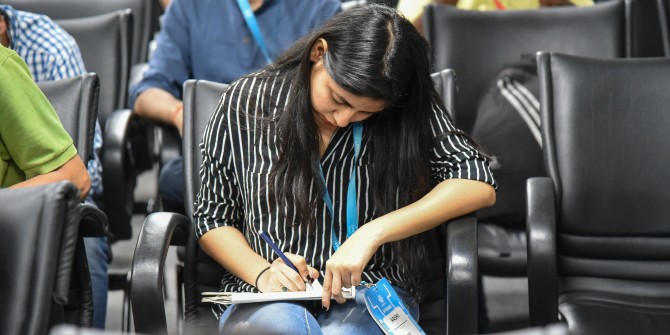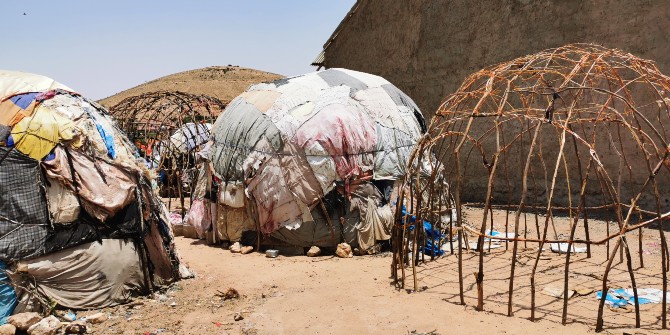Women in India are far less likely to be in paid work than men. The economic hardship caused by the pandemic has driven some into the workforce, but if they are to keep their jobs social norms will have to change. Laura Sili (International Growth Centre) looks at the challenges for India’s policymakers.
Even before the pandemic, India’s female labour force participation was the lowest in South Asia. In 2018, women made up just a fourth of India’s workforce, and 90 percent of those who were working were in informal employment, such as unpaid or irregular work. Similarly, the gender gap in unpaid work was alarmingly high. Women spent 312 minutes per day in urban areas and 291 minutes per day in rural areas on unpaid care work in 2018. By contrast, men spent only 29 minutes and 32 minutes respectively.
It was hardly surprising, then, that last year India dropped two spots to 131 out of 189 countries on the Human Development Index and scored low on the gender index. A UNDP report noted that women’s labour force participation rate was actually lower than in previous years. Since women have been disproportionately affected by the COVID-19, corrective policy measures to protect female workers, women’s food security, and reproductive health are key to India’s recovery and growth.
The International Growth Centre hosted a webinar as part of the LSE Festival 2021 to explore how India can adopt more gender inclusive policy planning and implementation, with LSE Professor of Gender and Development Naila Kabeer joined in conversation by Delhi-based Professor of Economics Farzana Afridi and Bill & Melinda Gates Foundation programme officer Diva Dhar.
As the crisis triggered by the pandemic unfolds, there is a need for more focused research efforts on vulnerable groups, who can easily be excluded from policy design and decisions. Farzana Afridi stressed the importance of analysing the impact of the pandemic on the social wellbeing of these vulnerable and marginalised groups.
One of the key findings from her work on the impact of the crisis on the urban poor is that, although financial concerns have been the main source of stress for both men and women, women have suffered from much greater mental distress. This is likely to continue, as the post-pandemic recovery for women is much slower and their probability of being employed is 9.5 percentage points lower than is for men, compared to the pre-pandemic period.

Throughout 2020, the restrictions imposed to control the spread of the virus have affected the delivery of food and nutrition programmes. Cultural traditions dictate that women are the first to experience hunger when resources are in short supply. Even pre-pandemic, Indian women used to consume nutrient-rich foods less frequently than men. Diva Dhar mentioned the importance of school meals for young girls, especially considering that parents’ treatment of girls and boys has been different during the pandemic, and has led to higher malnutrition among girls. A study by the economist Jean Dreze indicates that midday meals increase the likelihood of a girl completing primary school by 30 percent and reduce the proportion of girls not enrolled by approximately 50 percent. The disruption of school meals caused by COVID restrictions could lead to families withdrawing girls from schools.
Dhar also mentioned that although the government has stepped up its cash transfers and social protection programmes, they need to be more gender-intentional and address the challenges that prevent women from accessing them. Rohini Pande and colleagues found that more than half of poor women are probably excluded from the emergency COVID relief cash transfer programme that sent Rs 500 per month from April-June 2020 via India’s digital banking programme. Furthermore, one in five poor women live in households that lack ration cards, which typically grant access to the central food ration system.
Both speakers stressed that workfare programmes have largely been based in rural areas, and have not addressed the needs of poor urban women. In addition, a recent report suggests that states with a higher pre-pandemic capacity to generate work were able to cushion job losses, and more so for women in rural areas under the Mahatma Gandhi Employment Guarantee Act as the restrictions eased. The districts that benefited from the Pradhan Mantri Garib Kalyan Rozgar Abhiyan programme, an initiative for migrant labourers who came back to their villages during the national lockdown, witnessed a lower reduction in the employment rate, but only for urban women and the older workforce. The results indicate that employment guarantee programmes can benefit certain demographic groups more than others, depending on the wage and skill level of the work offered.
Women’s participation in the labour market in India tends to be anti-cyclical. The evidence suggests that women are more likely to find employment when the household income is drastically affected. However, women need additional support to enter the labour market post-pandemic, and that needs to be sustained by a change in social norms and a more flexible redistribution of unpaid care work. Afridi mentioned the importance of considering wages and the benefits of work for women. As seen in many developed countries, men are more likely to take on more unpaid caring responsibilities when they acknowledge the contribution of educated women’s income to the household expenses. Dhar added that broader change needs to happen within the educational system and government programmes.
The lack of women’s representation at the leadership level is another critical issue that needs to be addressed through legislation and implementation. Just 14 percent of Members of Parliament in India are women, and the rate of representation is even lower at the state level, with just 9 percent of the elected candidates in state legislative assemblies. An IGC study found that constituencies that elect women have higher growth in economic activity, and the female electorate tends to be more aligned with the priorities put forward by women policymakers. Both Afridi and Dhar stressed the importance of young girls seeing women in leadership positions to perpetuate change, as well as engaging men in conversations and actions promoting gender equality.
Read more about IGC’s work on gender.
This post represents the views of the author and not those of the COVID-19 blog, nor LSE.





